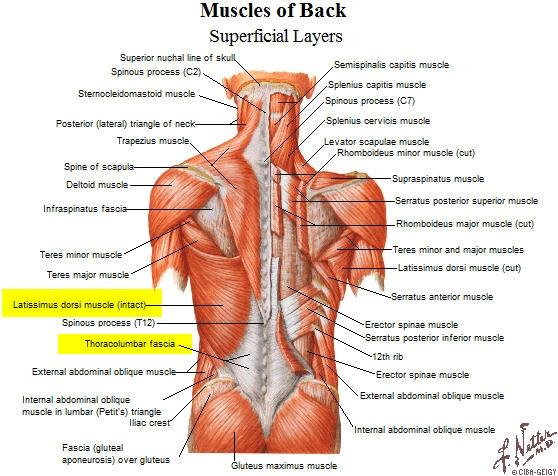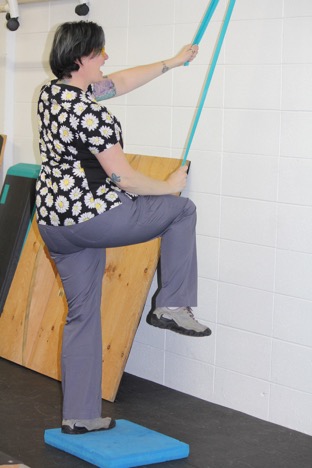Laurie's Blogs.
Jan 2017
Back and Leg Pain in Agility Handlers
By Margaret Kraeling, DPT, CCRT
At agility trials, I often hear handlers complaining of low back and knee pain after running their dogs all weekend. Certainly, the terrain is not ideal being either soft sand, uneven dirt (some sections softer than others) or grass which may be uneven and / or wet and slippery. Although we all try to use the best shoes possible it is still not an ideal situation.
There are, however, some other things to consider. One of these things is “handler control” of their body movements. Sadly, due to my profession as a physiotherapist one of my bad habits is watching people (as well as dogs) move. That may be watching people move around the agility course or watching people walk in the shopping mall. Both species can have a variety of movement dysfunctions (probably more noticeable in people). These dysfunctions over the long term can lead to break down in a specific joint or muscle and then cause pain (acute or chronic).
One of the primary systems of motion control in our bodies is the thoracolumbar fascia along with all of its muscle attachments. The thoracolumbar fascia is a sheet of dense connective tissue that covers the back and effectively connects the muscles of the upper body, lower body, and those around the middle. This system plays a critical role in both stabilization and load transfer. The thoracolumbar fascia integrates the actions of the muscles of the lower limb, upper limb, spine and pelvis. Two of the largest muscles in the body, the gluteus maximus and the latissimus dorsi, cohesively work to coordinate the motions of the upper and lower extremities on opposite sides. They do so via the thoracolumbar fascia!
Recent diagnostic imaging studies in people with low back pain of more than 12 months’ duration show changes in the thoracolumbar fascia. This may be as a result of injury or repetitive activities, and may represent fibrosis or adhesions which could then alter the normal function of these structures. In turn, this could alter the normal movement patterns that we rely on to move without pain.
Here are some of the signs related to poor function of the thoracolumbar fascia.
•Tightness, increased tone, tenderness of the paraspinal muscles (those that run along each side of the spinal column).
•Chronic low back pain with a fixed, increased curve in the lumbar spine
•Sacroiliac joint locking / fixation.
•Nagging shoulder and hip pain that does not improve with localized treatment to the painful areas.
•Difficulty with deep diaphragmatic breathing
•Decreased rotation in the mid-back.
•Limited range of motion of the hip joints.
•Altered gait patterns. Poor reciprocal arm/leg swing pattern.
•Compensations occurring such as headaches at the base of the skull or “plantar fasciitis”.
The approach to solving this problem is two pronged – firstly by releasing the tight fascial bands (which can be accomplished by a variety of techniques such as massage therapy, cupping, shock wave, myofascial release, etc) and secondly by engaging the appropriate muscles to control our movements – particularly transverse abdominis, the deep layer of internal oblique, gluteus maximus, latissimus dorsi and the superficial fibres of trapezius.

It is proposed that the compression of the Sacroiliac Joints (i.e. the back of the pelvis) occurs with the co-contraction of the gluteus maximus and the contralateral latissimus dorsi via the thoracolumbar fascia.
It has been observed that many people with low back pain have medially rotated femurs. It is thought that this medial rotation limits hip ROM in extension and thoracolumbar fascia aides in the stabilization of the sacroiliac joints, which is important during gait. Poor glute control may compromise lumbo-pelvic stability in functional activities such as walking, running, stairs and even getting up from a seated or bent position.
Standing on one leg requires the hip abductor mechanism (i.e. all the glutes and their ‘friends’) to provide a force to counterbalance the body weight. Poor control of these abductor muscles can also cause increased stress on the lumbo-pelvic region.
A lack of glute max control may lead to excessive loading of hip joints, pelvis and lumbar spine which may produce repetitive micro-trauma eventually leading to clinical instability and pain.
The same can be said of a lack of gluteus medius control (Gluteus Medius is the little brother to glute max… he’s a bit more into control and coordination and not just heavy lifting). If gluteus maximus and/or gluteus medius are compromised the tensor fascia latae (IT band that runs down the side of your leg) may begin to take over. However, this is not an action this muscle is designed to do and may lead to a loss of normal hip extension and excessive medial rotation when walking.
An approach to treatment of these fascial and muscle imbalances is complex and must address all the areas discussed including transverse abdominals, diaphragmatic breathing, lumbar multifidus and glutes. These muscles must be balanced in strength and be recruiting in the correct pattern and with the appropriate timing.
Although this sounds rather complex there are many home exercises that don’t require any fancy equipment or an extended amount of time.
Below is a picture of one of my favorite exercises showing balance in single leg stand engaging the glutes on the left side along with latissimus dorsi on the right.
Carrie is doing a beautiful job below!!!
I encourage you to try the same!!!



